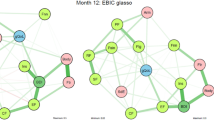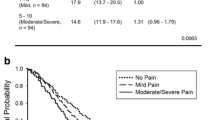Abstract
Objectives
To explore to what extent the daily reporting of anxiety, depression and activity in a diary mirrors scores on point assessments with the Hospital Anxiety and Depression scale (HADS).
Methods
In a randomized intervention study consecutive breast cancer patients (n = 179) about to start adjuvant therapy were included. The HADS questionnaires were sent to patients 3 and 12 months after inclusion. Daily reporting of anxiety, depression and activity on Visual Analogue Scales (VAS) were completed during 4 weeks surrounding the HADS assessments.
Results
The results showed moderate correlations (r = −0.36 to −0.67, P < 0.01) at both assessments. The daily reports were consistent over 4 weeks and did not differ between assessments. Mean scores on the HAD-Anxiety were 4.00 at the 3 months and 5.07 at the 12 months assessment. For the HAD-Depression the mean scores at the same assessment points were 3.61 and 3.23, respectively. The daily reports put more strain on the respondents and produced a larger attrition rate than the HADS.
Conclusion
A point assessment with the HADS captures the situation of breast cancer patients’ equivalent to 4 weeks assessment in a diary, but is easier to complete and is therefore preferable to the diary.
Similar content being viewed by others
References
Boman, L., et al. (1997). Needs as expressed by women after breast cancer surgery in the setting of a short hospital stay. Scandinavian Journal of Caring Sciences, 11, 25–32.
Brandberg, Y., et al. (2003). Quality of life in women with breast cancer during the first year after random assignment to adjuvant treatment with marrow-supported high-dose chemotherapy with cyclophosphamide, thiotepa, and carboplatin or tailored therapy with Fluorouracil, epirubicin, and cyclophosphamide: Scandinavian Breast Group Study 9401. Journal of Clinical Oncology, 21, 3659–3664.
Hanson Frost, M., et al. (2000). Physical, psychological and social well-being of women with breast cancer: The influence of disease phase. Psycho-oncology, 9, 221–231.
McArdle, J. M., et al. (1996). Psychological support for patients undergoing breast cancer surgery: A randomised study. British Medical Journal, 312, 813–816.
Savard, J., et al. (2005). Randomized study on the efficacy of cognitive-behavioral therapy for insomnia secondary to breast cancer, part I: Sleep and psychological effects. Journal of Clinical Oncology, 23, 6083–6096.
Larson, M. R., et al. (2000). A presurgical psychosocial intervention for breast cancer patients: Psychological distress and the immune response. Journal of Psychosomatic Research, 48, 187–194.
Stiegelis, H. E., et al. (2004). Psychological functioning in cancer patients treated with radiotherapy. Patient Education and Counseling, 52, 131–141.
Burgess, C., et al. (2005). Depression and anxiety in women with early breast cancer: Five year observational cohort study. British Medical Journal, 330, 702.
Deshields, T., et al. (2006). Differences in patterns of depression after treatment for breast cancer. Psycho-oncology, 15, 398–406.
Zigmond, A. S., et al. (1983). The hospital anxiety and depression scale. Acta Psychiatric Scandinavia, 67, 361–370.
Morasso, G., et al. (2001). Predicting mood disorders in breast cancer patients. European Journal of Cancer, 37, 216–223.
Montazeri, A., et al. (2001). Anxiety and depression in breast cancer patients before and after participation in a cancer support group. Patient Education and Counseling, 45, 195–198.
Turner, J., et al. (2005). Psychosocial impact of newly diagnosed advanced breast cancer. Psycho-oncology, 14, 396–407.
Herrmann, C. (1997). International experiences with the Hospital Anxiety and Depression Scale-a review of validation data and clinical results. Journal of Psychosomatic Research, 42, 17–41.
Johnston, M., et al. (2000). Construct validation of the hospital anxiety and depression scale with clinical populations. Journal of Psychosomatic Research, 48, 579–584.
Costantini, M., et al. (1999). Detecting psychological distress in cancer patients: Validity of the Italian version of the Hospital Anxiety and Depression Scale. Supportive Care Cancer, 7, 121–127.
Bjelland, I., et al. (2002). The validity of the Hospital Anxiety and Depression Scale. An updated literature review. Journal Psychosomatic Research, 52, 69–77.
Akizuki, N., et al. (2003). Development of a brief screening interview for adjustment disorders and major depression in patients with cancer. Cancer, 97, 2605–2613.
Osborne, R. H., et al. (2004). The value of the Hospital Anxiety and Depression Scale (HADS) for comparing women with early onset breast cancer with population-based reference women. Quality of Life Research, 13, 191–206.
Barofsky, I., et al. (2003). Cognitive aspects of survey methodology and quality of life assessment: Summary of meeting. Quality of Life Research, 12, 281–282.
McColl, E., et al. (2003). Cognitive aspects of survey methodology and quality of life assessment. Quality of Life Research, 12, 217–218.
Levesque, M., et al. (2004). Efficacy of cognitive therapy for depression among women with metastatic cancer: A single-case experimental study. Journal of Behavioral Therapy Experimental Psychiatry, 35, 287–305.
Curran, S. L., et al. (2004). Ecological momentary assessment of fatigue following breast cancer treatment. Journal of Behavioral Medicine, 27, 425–444.
Arving, C., et al. (2007). Individual psychosocial support for breast cancer patients: A randomized study of nurse versus psychologist interventions and standard care. Cancer Nursing, 30, E10–E19.
Moorey, S., et al. (1989). Psychological therapy for patients with cancer. A new approach. Oxford: Heinemann Medical Books.
Hawton, K. (1989). Cognitive behavior therapy for psychiatric problems/ a practical guide. Oxford : Oxford University Press.
Arving, C., et al. (2006). Satisfaction, utilisation and perceived benefit of individual psychosocial support for breast cancer patients-a randomised study of nurse versus psychologist interventions. Patient Education and Counseling, 62, 235–243.
Lundqvist, C., et al. (1991). Spinal cord injuries. Clinical, functional, and emotional status. Spine, 16, 78–83.
Nyrén, O. (1988). Visual analogue scale. In A. S. Bellack & M. Hersen (Eds.), Dictionary of behavioral assessment techniques (pp. 490–492). New York; Oxford: Pergamon.
Gil, F., et al. (2005). Use of distress and depression thermometers to measure psychosocial morbidity among southern European cancer patients. Supportive Care Cancer, 13, 600–606.
Jacobsen, P. B., et al. (2005). Screening for psychologic distress in ambulatory cancer patients. Cancer, 103, 1494–1502.
Bardwell, W. A., et al. (2006). Objective cancer-related variables are not associated with depressive symptoms in women treated for early-stage breast cancer. Journal of Clinical Oncology, 24, 2420–2427.
Streiner, D. L., et al. (2001). Health measurement scales. A practical guide to their development and use. Oxford: Oxford University Press.
Ransom, S., et al. (2006). Validation of the Distress Thermometer with bone marrow transplant patients. Psycho-oncology, 15, 604–12.
Montazeri, A., et al. (2000). Anxiety and depression in Iranian breast cancer patients before and after diagnosis. European Journal of Cancer Care (Engl), 9, 151–157.
Tourangeau, R. R. L., & Rassinski, K. (2000). The psychology of survey response. Cambridge: Cambridge University Press.
Acknowledgements
The study was supported by grants from the Swedish Cancer Society.
Author information
Authors and Affiliations
Corresponding author
Rights and permissions
About this article
Cite this article
Arving, C., Glimelius, B. & Brandberg, Y. Four weeks of daily assessments of anxiety, depression and activity compared to a point assessment with the Hospital Anxiety and Depression Scale. Qual Life Res 17, 95–104 (2008). https://doi.org/10.1007/s11136-007-9275-4
Received:
Accepted:
Published:
Issue Date:
DOI: https://doi.org/10.1007/s11136-007-9275-4




